HistoryByzance
Walls, Gates & Pillars
Ottoman Period
Ottoman Complexes
Madrassahs & Libraries
Tombs & Graves
Palaces & Fortresses
Fountains, Baths
Bazaars & Caravanserais
Bosphorus & Residences
Istanbul Museums |
History
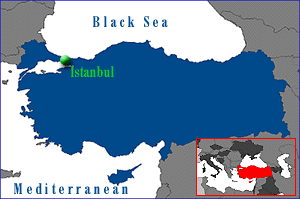 Due to her
geographic location, Istanbul has always been a settlement area from early ages onwards.
And besides connecting the two continents, Europe and Asia, Istanbul has become a center
where various cultures and religions are combined, surrived and succeeded each other. Due to her
geographic location, Istanbul has always been a settlement area from early ages onwards.
And besides connecting the two continents, Europe and Asia, Istanbul has become a center
where various cultures and religions are combined, surrived and succeeded each other.
Istanbul of the day conforms the definition of a
great city, not only with her population and the area she covers but also with the variety
of cultures and ways of living. This cultural structure which enables a good number of
elements that contradict with each other and yet exist together even one in another, is
the produce of an accumulation of about one thousand years. Although first settlements in
Istanbul were observed in prehistoric periods, continual settlements, however, have
started in the colonial period. Foundations of Istanbul of our days were laid during
recent periods of the Roman Empire. Byzantium and Ottoman periods are the most significant
stages in the history of Istanbul. In both of these periods, Istanbul has preserved her
features of being a political and religious center and has become the religious center of
both, the Christianity and the Islam. Therefore, she was ornamented with many great
monuments with different functions belonging to these
two religions. Although Ankara was elected to be the capital during the Republic period,
Istanbul conserved her characteristic of being the cultural capital.
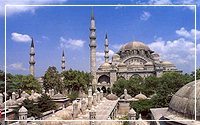 First settlements forming the nucleus of today's city were
realized by Megarians in the 7th century BC. They run away from Greece invaded by Dors,
crossed the Sea of Marmara in BC 680 and settled in the city they established with the
name Chalcedon on the Cape of Moda in Kadik�y and engaged in agriculture. Another branch
of Megarians settled down in the vicinity of Sarayburnu under the
leadership of Byzas (Point of Seraglio) in 660 BC. They named this place Byzantion. They
engaged in Commerce. This area was seized by Persians in 513 BC, then by Spartians in 405
BC and by Antigers, one of the commanders of Alexander the Great, in 318 BC. And
completely attached to Rome in 74 BC. It was within the boundries of BithyniaPontus State
of Rome in 73 AD. In 330, Constantine I, Emperor of Rome, proclaimed the city as the
capital. And the name Byzantion was converted to Constantinopolis. Then, with adoption of
christianity, she became the most important culture and art center of christianity
throughout the medieval age. Later on she became the political and economic center (395).
After partition of Roman Empire in two parts, she became the capital of the East Roman
Empire (Byzantium Empire). New sections formed as a result of growth in the population of
the town. Subjected to the aggression of the Huns in 440. During First settlements forming the nucleus of today's city were
realized by Megarians in the 7th century BC. They run away from Greece invaded by Dors,
crossed the Sea of Marmara in BC 680 and settled in the city they established with the
name Chalcedon on the Cape of Moda in Kadik�y and engaged in agriculture. Another branch
of Megarians settled down in the vicinity of Sarayburnu under the
leadership of Byzas (Point of Seraglio) in 660 BC. They named this place Byzantion. They
engaged in Commerce. This area was seized by Persians in 513 BC, then by Spartians in 405
BC and by Antigers, one of the commanders of Alexander the Great, in 318 BC. And
completely attached to Rome in 74 BC. It was within the boundries of BithyniaPontus State
of Rome in 73 AD. In 330, Constantine I, Emperor of Rome, proclaimed the city as the
capital. And the name Byzantion was converted to Constantinopolis. Then, with adoption of
christianity, she became the most important culture and art center of christianity
throughout the medieval age. Later on she became the political and economic center (395).
After partition of Roman Empire in two parts, she became the capital of the East Roman
Empire (Byzantium Empire). New sections formed as a result of growth in the population of
the town. Subjected to the aggression of the Huns in 440. During 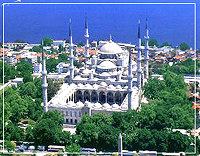 the
periods of Anastasios I (491-518) and Justinianos I (527-565), she became the scene of
civil wars and uprisals. Sycae which gained importance in the period of Justinianos I, was
connected to the city with a bridge over the Golden Horn. The town was attacked by
Sassanians and Avars in 7th century, by Bulgarians and �rabs in 8th century and by
Russians and Bulgarians in 9th century, but they could not capture the town. Crusaders
attacked and captured the town in 1204. Damaged it immensly. Town was the capital of the
Latin Empire till 1261. New trade relations emerged due to crusades. Town started
collapsing more and more. Ottomans sieged the town first in the periods of Beyazid I
(13891402) and Murat II (1422). Mehmet II added the town to the lands of Ottoman Empire in
1453. Capital of the Ottoman Empire, was moved from Adrianople to Constantinopolis. The
city became the Capital of Caliphate in Selim I's period (1517). Name of the town after
some changes became Istanbul. Fires and earthquakes damaged the town to a great extent,
during Balkan war which started in 1912 with dethronment of Abd�lhamit II and World War
I, the town was occupied and damaged immensely. After establishment of TBMM (Great
National Assembly of Turkey) in Ankara on 23 April 1920, Mehmet VI the last Ottoman Sultan
left the town. The town then was placed under the control of the TBMM Government and
liberated from occupation (6 October 1923). Then it became the culture and art center of
the republican period, which has been maintained upto date. the
periods of Anastasios I (491-518) and Justinianos I (527-565), she became the scene of
civil wars and uprisals. Sycae which gained importance in the period of Justinianos I, was
connected to the city with a bridge over the Golden Horn. The town was attacked by
Sassanians and Avars in 7th century, by Bulgarians and �rabs in 8th century and by
Russians and Bulgarians in 9th century, but they could not capture the town. Crusaders
attacked and captured the town in 1204. Damaged it immensly. Town was the capital of the
Latin Empire till 1261. New trade relations emerged due to crusades. Town started
collapsing more and more. Ottomans sieged the town first in the periods of Beyazid I
(13891402) and Murat II (1422). Mehmet II added the town to the lands of Ottoman Empire in
1453. Capital of the Ottoman Empire, was moved from Adrianople to Constantinopolis. The
city became the Capital of Caliphate in Selim I's period (1517). Name of the town after
some changes became Istanbul. Fires and earthquakes damaged the town to a great extent,
during Balkan war which started in 1912 with dethronment of Abd�lhamit II and World War
I, the town was occupied and damaged immensely. After establishment of TBMM (Great
National Assembly of Turkey) in Ankara on 23 April 1920, Mehmet VI the last Ottoman Sultan
left the town. The town then was placed under the control of the TBMM Government and
liberated from occupation (6 October 1923). Then it became the culture and art center of
the republican period, which has been maintained upto date.
Historical Buildings
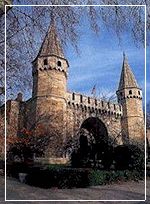 Due to her geographical location, Istanbul has always been a settlement area from
prehistorical times to present days. The city bears the characteristic of being capital
city of two Great Empires like Byzantium and Ottoman. Therefore, she is one of the few
cities which hold diverse cultures rich from the standpoint of historical values.
Prehistorical settlements in Istanbul start with the Chalcolithic period. However,the
Paleolithic culture has been rendered in the Yarimburgaz Cave of Kucukcekmece. In Kadikoy
(Chalcedon) there are remains of buildings from Phoenicians. Also, remains of the walls of
the town called Lygos (5500-3500 BC) were found. Stratification in the caves were found in
excavations made in the name of Turkish History Association. On the top, Byzantium
settlement and on the main rock layer Paleolithic settlement in between chalcolithic
settlement phases were determined. Also during Fikirtepe excavations, findings from
chalcolithic period were rendered. Architecture of pendik mound is not known sufficiently. Due to her geographical location, Istanbul has always been a settlement area from
prehistorical times to present days. The city bears the characteristic of being capital
city of two Great Empires like Byzantium and Ottoman. Therefore, she is one of the few
cities which hold diverse cultures rich from the standpoint of historical values.
Prehistorical settlements in Istanbul start with the Chalcolithic period. However,the
Paleolithic culture has been rendered in the Yarimburgaz Cave of Kucukcekmece. In Kadikoy
(Chalcedon) there are remains of buildings from Phoenicians. Also, remains of the walls of
the town called Lygos (5500-3500 BC) were found. Stratification in the caves were found in
excavations made in the name of Turkish History Association. On the top, Byzantium
settlement and on the main rock layer Paleolithic settlement in between chalcolithic
settlement phases were determined. Also during Fikirtepe excavations, findings from
chalcolithic period were rendered. Architecture of pendik mound is not known sufficiently.
Place of Istanbul in
tourism
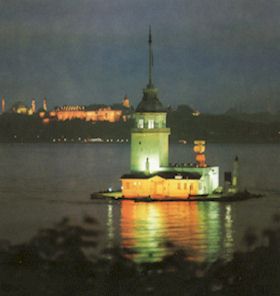 Istanbul, with her natural beauties and rich history, is
a town with high local and international tourism potential, and from this view point one
of the most attractive towns of the world. Besides her natural beauties, Istanbul has a
lot of historical works remaining from the Byzantium and Ottoman periods.Especially the
trio of Topkapi Palace, St Sophia Museum located in Sultanahmet Section and the Kariye
Museum are the places which attract the utmost interest of foreign tourists. 870,000
persons have visited the Topkapi Palace in 1997. Number of persons visited the St Sophia
Museum during the same period is 650,000. Touristic significance of mosques such as
Sultanahmet (Blue Mosque), S�leymaniye and magnificient palaces, fountains, tombs,
founded charities (such as roads, public water distribution points), Turkish baths;
historical structures like churches, cisterns, walls etc. remaining from Byzantium period
is great. Istanbul, with her natural beauties and rich history, is
a town with high local and international tourism potential, and from this view point one
of the most attractive towns of the world. Besides her natural beauties, Istanbul has a
lot of historical works remaining from the Byzantium and Ottoman periods.Especially the
trio of Topkapi Palace, St Sophia Museum located in Sultanahmet Section and the Kariye
Museum are the places which attract the utmost interest of foreign tourists. 870,000
persons have visited the Topkapi Palace in 1997. Number of persons visited the St Sophia
Museum during the same period is 650,000. Touristic significance of mosques such as
Sultanahmet (Blue Mosque), S�leymaniye and magnificient palaces, fountains, tombs,
founded charities (such as roads, public water distribution points), Turkish baths;
historical structures like churches, cisterns, walls etc. remaining from Byzantium period
is great.
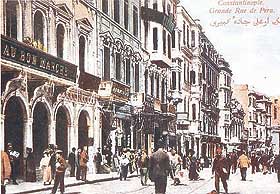 Istanbul is also important as a shopping center
for foreign tourists. In this relation, historical and economic values of the Covered
Bazaar is significant. On daily basis, approximately 7,000 tourists visit this market
which has a surface area of 47,600 sq., 61 streets and about 3,600 shops and also a
touristic coffee-house. Istanbul is highly suitable for the development of "Cultural
Tourism". In recent years, many cultural conferences of international character, were
arranged in the town. Additional facilities are made for the development of "Congress
Tourism". Istanbul is also important as a shopping center
for foreign tourists. In this relation, historical and economic values of the Covered
Bazaar is significant. On daily basis, approximately 7,000 tourists visit this market
which has a surface area of 47,600 sq., 61 streets and about 3,600 shops and also a
touristic coffee-house. Istanbul is highly suitable for the development of "Cultural
Tourism". In recent years, many cultural conferences of international character, were
arranged in the town. Additional facilities are made for the development of "Congress
Tourism".
Book a Hotel near Istanbul
Source : ICOC Nilgun Saraloglu |

